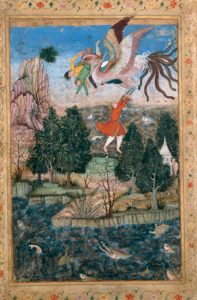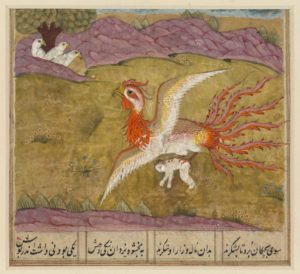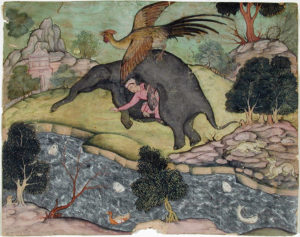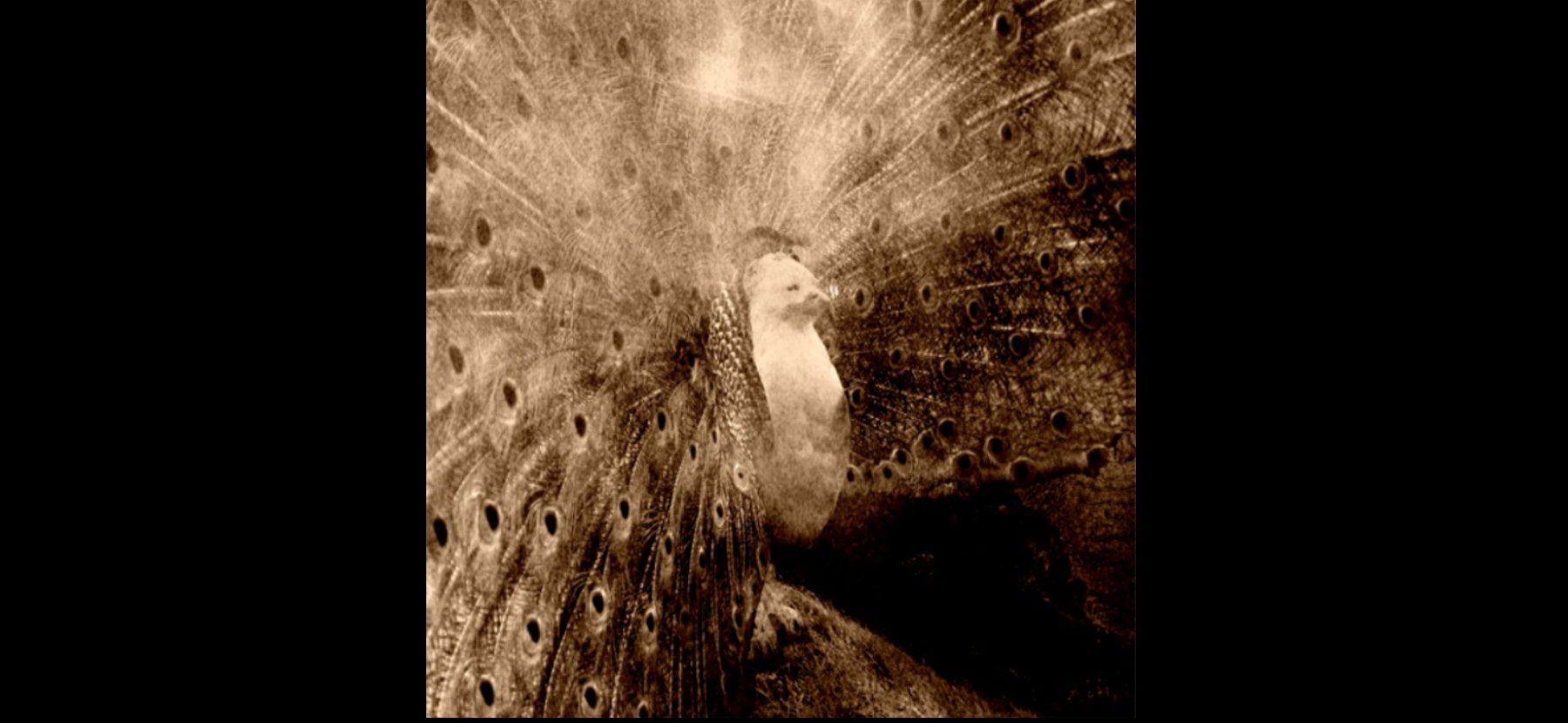This piece, which is one of the most popular Kotebel works, is based on the description of this creature as it appears in the Book of Imaginary Beings written by Jorge Luis Borges:
Basawan. The Flight of the Simurgh (ca. 1590):

The Simurgh carries Zal to her nest:

A man hides in an elephant skin and is carried off by a giant Simurgh:

The structure of Simurgh is nested, and describes the journey of the birds to the castle that lies in the Kaf. The initial theme gives rise to subsequent themes and developments, one inside the other. The initial theme doesn’t appear again until the end, giving the piece a cyclic nature that symbolizes what happens at the end of their journey: They are the Simurgh and the Simurgh is each of them and all of them.
The mood of the piece at the beginning of the piece reflects the idealistic aspiration of finding the Simurgh. The subsequent themes and developments clearly reflect the struggle of the birds, most of which abandon the journey. The last section retakes the initial theme but with a stronger nerve and drive. This reflects the revelation of the few birds that discover that the purpose of the trip was the trip itself.
For the examples of this analysis I will use the live version of the piece, as it appears in the double CD Live at Prog-Résiste Limited Edition.
The Structure of Simurgh is a large binary form with an intro and an interlude:
Intro-A-B-Interlude-A’
“A” has its own structure and “B” has a complex nested structure. We will leave the detailed analysis of section B for a future article.
Intro
Represents the moment when the birds discover the Simurgh’s feather. They are in awe, and try to interpret the meaning of this finding. When they decide to start their journey to the castle in the Kaf mountains, section “A” starts.
Section A
This section has the structure: a-b-a’-b’ (bridge)
“a” presents the theme and note that there is no fluid rhythmic pattern but instead a succession of beats. The birds are still gathered around the feather:
“b” symbolizes the discussion that takes place among the group. The drums are absent and the music turns into a more tranquil mood. Finally, they decide to embark on the adventure:
“a’ ” is a restatement of “a” but with a dynamic rhythmic pattern that clearly conveys the idea that the birds are on their way:
“b’ (bridge)” – This fragment is really an introduction to the long development section “B”. Theme “b” is exposed twice: first with flowing arpeggios and the same bass beats used in the introduction, then a soaring guitar solo develops theme “b” and is supported by a strong drum beat that takes you directly in to the conflict zone (section B):
Section B
Section B is a long and complex section that represents the voyage with the multitude of problems and abandonments that they experience until they finally reach the foot of the Kaf mountains. As I explained, the structure is nested and will be detailed in a future article. If you want to try to figure out the structure, here’s an outline:
a(b(c(d)c)b)
So, part B goes deeper into subsequent levels until reaching “d”, and then works its way back up by revisiting modified versions of the previous themes. Theme “a” is the only one that does not reappear.
Let’s listen to section “B”:
Interlude
The group finally reaches the foot of the Kaf mountains. They stop for a moment and meditate, wondering about the great revelation that they will receive upon meeting the Simurgh:
Section A’
Themes “a” and “b” are developed in such a way as to represent the moment when they realize that they are the Simurgh, and that the Simurgh is each of them and all of them. Finally, theme “A” is re-exposed in its original tonality; the journey has ended – they finally understand.
Theme “a” is prolonged to form a sort of coda. Let’s listen to the entire section:
This is the MIDI template of the piece exactly as I originally conceived it, before sharing it with the other band members. It is another good example that shows the importance of the contribution of the rest of the band when working the arrangements:
This is a previously unreleased Kotebel performance of Simurgh at the New Jersey ProgHouse – Roxy & Dukes, Dunellen, New Jersey – August 26, 2014.
Credits
Song written by Carlos G. Plaza Vegas. Arrangements by Carlos G. Plaza and Kotebel.
Carlos Franco: Drums and percussion
César G. Forero: Guitars
Jaime Pascual Summers: Bass
Adriana Plaza Engelke: Keyboards
Carlos G. Plaza Vegas: Piano
© 2009 Carlos G. Plaza Vegas. All rights reserved.



One of the many superior highlights of an album that is, in itself, a highlight.
🙂